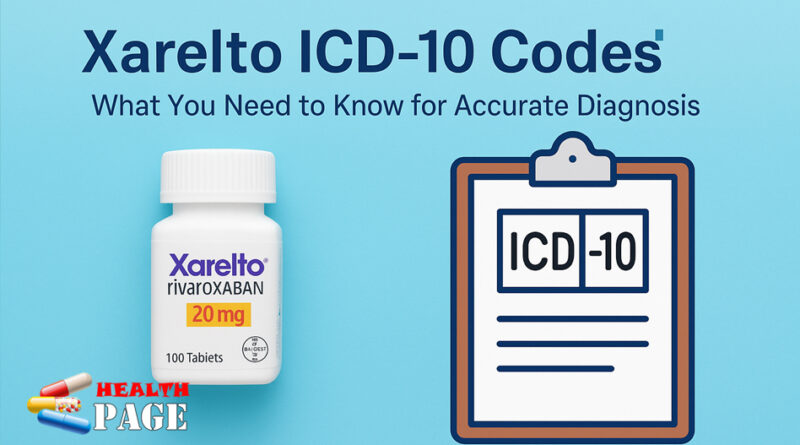Xarelto ICD 10 Codes: What You Need to Know for Accurate Diagnosis
Understanding Xarelto ICD 10 codes is important for healthcare professionals and medical coders. These codes help ensure proper documentation and billing. Accurate coding also supports better patient care and clear communication between providers.
What Are ICD 10 Codes?
ICD 10 codes are part of the International Classification of Diseases system. They are used worldwide to record diagnoses, symptoms, and medical procedures. These codes help track diseases and guide treatment plans.
Here is a simple breakdown:
| Code Type | Purpose |
|---|---|
| Diagnosis Code | Identifies health conditions |
| Procedure Code | Describes medical actions taken |
| Drug Use Code | Links medications to treatments |
Importance of Accurate Diagnosis in Healthcare
Correct diagnosis is the foundation of effective care. Using the right ICD 10 code prevents errors and ensures insurance approval. It also avoids delays in treatment and protects against claim rejections.
Brief Introduction to Xarelto and Its Relevance in ICD 10 Coding
Xarelto is a blood thinner used to prevent and treat blood clots. It is often prescribed for conditions like deep vein thrombosis or atrial fibrillation. Each condition linked to Xarelto must have the correct Xarelto ICD 10 code. This ensures that the treatment is coded accurately and reimbursed properly.
Healthcare providers must know the right codes for conditions requiring Xarelto. In the sections ahead, we’ll explore common Xarelto ICD 10 codes, when to use them, and why they matter.
What is Xarelto?
Xarelto is a prescription medicine used to prevent and treat blood clots. It belongs to a group of drugs called anticoagulants. These are often known as blood thinners.
Xarelto: A Blood-Thinning Medication Explained
Xarelto helps reduce the risk of dangerous clots forming in your blood vessels. It works by blocking a specific clotting protein in the blood, known as Factor Xa. This stops blood clots from forming too easily.
Unlike older blood thinners, Xarelto does not need regular blood testing. It also has fewer food and drug restrictions.
How Xarelto Helps Prevent Blood Clots
Xarelto is especially useful for people at risk of stroke or clot-related issues. It lowers the chance of a clot blocking blood flow in the brain, lungs, or legs.
Here’s how Xarelto works:
| Action | Effect |
|---|---|
| Blocks Factor Xa | Slows blood clotting |
| Prevents new clot formation | Reduces risk of stroke or pulmonary embolism |
| Thins the blood | Improves blood flow and reduces blockage risks |
Common Conditions Treated with Xarelto
Doctors often prescribe Xarelto for the following:
- Atrial fibrillation (irregular heartbeat)
- Deep vein thrombosis (DVT)
- Pulmonary embolism (PE)
- After hip or knee replacement surgery
Using Xarelto ICD 10 codes for these conditions ensures correct diagnosis and billing. Accurate coding is key for proper treatment and insurance claims.

Understanding ICD 10 Codes
Definition and Purpose of ICD 10 Codes
ICD 10 stands for the International Classification of Diseases, 10th Revision. These codes are used worldwide to classify diseases, conditions, and other health issues. Each code represents a specific diagnosis or symptom.
The main purpose of ICD 10 codes is to ensure consistency in recording and reporting health data. These codes make communication easier between healthcare providers, hospitals, and insurance companies.
How ICD 10 Codes Are Used in Medical Billing
ICD 10 codes play a big role in the medical billing process. When a patient visits a doctor, the diagnosis is recorded using the proper ICD 10 code. This code is then used in the medical claim sent to insurance companies.
Here’s how the process works:
| Step | Action |
|---|---|
| Patient Visit | Diagnosis is made |
| Code Assignment | ICD 10 code is selected |
| Billing Submission | Code is sent to insurance for approval |
| Claim Processing | Insurance reviews the code and pays claim |
Using the correct ICD 10 code avoids billing errors and delays in payments.
Benefits of Standardized Coding for Healthcare Providers
Standardized coding offers many advantages, such as:
- Improved patient care
- Easier data sharing across systems
- Accurate billing and faster claim approvals
- Better tracking of health trends and conditions
When used correctly, ICD 10 codes help doctors, coders, and insurers work more efficiently. For patients on Xarelto, using correct Xarelto ICD 10 codes ensures proper treatment and coverage.
Xarelto ICD 10 Codes Explained
Specific ICD 10 Codes Associated with Xarelto Usage
Xarelto ICD 10 codes are used when a patient is prescribed Xarelto for specific medical conditions. These codes help link the drug to the exact reason for its use. They ensure accurate diagnosis, treatment, and billing.
Examples of Relevant Codes for Its Prescriptions
Here are some common ICD 10 codes linked to Xarelto prescriptions:
| Condition | ICD 10 Code |
|---|---|
| Atrial Fibrillation | I48.91 |
| Deep Vein Thrombosis (DVT) – Lower Leg | I82.401 |
| Pulmonary Embolism (PE) | I26.99 |
| Post-Surgical DVT (Orthopedic) | Z96.651 |
| History of Pulmonary Embolism | Z86.718 |
Each code corresponds to a specific condition Xarelto is designed to treat or prevent.
Conditions Linked to Xarelto and Their ICD 10 Codes
Xarelto is prescribed for both prevention and treatment. Here are the key conditions and their ICD 10 codes:
- Non-valvular Atrial Fibrillation – I48.91
- Acute DVT of lower extremity – I82.4 series
- Pulmonary Embolism (unspecified) – I26.99
- Post-op DVT risk – Z96.651
Using these codes helps healthcare providers justify the prescription and ensures proper reimbursement.
How These Codes Guide Diagnosis and Treatment Plans
Accurate Xarelto ICD 10 coding helps:
- Confirm the need for anticoagulation
- Track patient progress and risks
- Prevent claim denials due to mismatched diagnoses
- Ensure clinical decisions are well-documented
Correct coding supports effective treatment and clear communication between doctors and payers.
Importance of Accurate Coding
Ensuring Proper Documentation for Patient Safety
Accurate coding ensures that each patient’s condition is clearly recorded. It helps doctors choose the right treatments. When Xarelto ICD 10 codes are used correctly, they reflect the true reason for the medication.
Proper documentation helps in:
- Tracking the patient’s medical history
- Avoiding harmful drug interactions
- Monitoring the effectiveness of treatment
This leads to safer and more effective care.
Avoiding Errors in Medical Billing and Claims
Incorrect or missing ICD 10 codes can cause claim rejections. This may delay treatment or result in billing issues. When providers use the correct Xarelto ICD 10 codes, it ensures:
- Faster claim approvals
- Fewer billing errors
- Reduced costs for patients and clinics
Accurate billing also helps healthcare organizations avoid penalties and audits.
Supporting Effective Communication Among Healthcare Providers
ICD 10 codes act as a universal language in healthcare. When shared among hospitals, clinics, and insurance companies, they help everyone stay informed.
With precise coding:
- Referrals become easier
- Patient records stay consistent across systems
- All providers stay updated on diagnoses and treatment plans
This teamwork improves care quality and patient outcomes. Using accurate Xarelto ICD 10 codes supports a smoother healthcare experience for everyone involved.

Challenges in Coding for Xarelto
Common Mistakes When Assigning ICD 10 Codes for Xarelto
Medical coders sometimes make errors when linking Xarelto to the right diagnosis. These mistakes can lead to claim denials or treatment delays.
Common errors include:
- Using general codes instead of specific ones
- Missing the link between Xarelto and the diagnosed condition
- Forgetting to add supporting documentation for high-risk conditions
For example, using a non-specific DVT code instead of I82.401 for a confirmed lower leg clot.
Challenges Faced by Medical Coders
Medical coders often work under pressure. They must review complex records and match them with exact codes. Challenges include:
- Incomplete physician notes
- Unclear documentation of why Xarelto was prescribed
- Frequent updates to ICD 10 guidelines
- Similar conditions with different codes
These issues make it hard to choose the correct Xarelto ICD 10 code.
How to Overcome These Obstacles
Coders and healthcare teams can take steps to avoid mistakes and improve accuracy:
- Stay updated on ICD 10 code changes
- Use coding software with real-time suggestions
- Communicate with providers for clearer documentation
- Attend regular training to stay informed on coding practices
Here’s a simple guide to reduce errors:
| Solution | Benefit |
|---|---|
| Detailed provider notes | Easier code selection |
| Coding audits | Identify and fix patterns of errors |
| Clear Xarelto diagnosis link | Faster billing and fewer claim issues |
Accurate use of Xarelto ICD 10 codes improves billing, reduces risk, and supports better patient care.
Tips for Accurate ICD 10 Coding
Steps to Ensure Correct Coding Practices
Accurate ICD 10 coding is essential for quality care and smooth billing. Follow these steps to improve coding accuracy:
- Always review the complete medical record.
- Use the most specific ICD 10 code available.
- Double-check that the code matches the diagnosis.
- Ensure Xarelto prescriptions are clearly linked to the diagnosed condition.
- Verify codes before submitting claims.
These simple steps help reduce errors and improve patient outcomes.
Tools and Resources for ICD 10 Coding Guidance
Several tools are available to support medical coders and providers in using the correct Xarelto ICD 10 codes:
- ICD 10 codebooks – Updated annually with new guidelines.
- Coding software – Helps suggest accurate codes based on documentation.
- Online code lookup tools – Easy access to current codes.
- CMS and WHO websites – Provide official updates and coding instructions.
These tools make it easier to stay accurate and up to date.
Importance of Regular Training for Healthcare Professionals
ICD 10 guidelines change regularly. Regular training helps coders and providers stay informed and avoid costly mistakes.
Benefits of training include:
- Improved coding accuracy
- Faster billing processes
- Better communication across healthcare teams
- Stronger documentation practices
Hospitals and clinics should invest in regular workshops, webinars, or certification courses. When healthcare teams are train well, they’re more confident and efficient with coding tasks.
Using correct Xarelto ICD 10 codes is easier with the right knowledge, tools, and habits in place.
Impact of Xarelto ICD 10 Codes on Healthcare
Role in Improving Patient Outcomes
Accurate use of Xarelto ICD 10 codes plays a vital role in patient care. These codes help track the exact reason for prescribing Xarelto. They ensure patients receive the correct treatment based on their medical condition.
With proper coding:
- Doctors can monitor treatment progress.
- Risks of complications are reduced.
- Patient safety improves through consistent documentation.
This leads to better care and healthier outcomes for patients using Xarelto.
Contribution to Efficient Healthcare Management
ICD 10 coding makes healthcare systems run more smoothly. When the correct code is use for Xarelto:
- Billing is faster and more accurate.
- Insurance approvals are quicker.
- Treatment plans are easier to follow and adjust.
It also helps reduce waste and avoid duplicate treatments. This creates a more organized and cost-effective healthcare system.
Supporting Medical Research Through Reliable Data
ICD 10 codes create a reliable database for researchers. Accurate Xarelto ICD 10 codes help track how and why the medication is use.
Benefits for research include:
- Studying drug effectiveness across populations
- Identifying trends in blood clot-related conditions
- Improving future treatment guidelines
This data also helps public health officials make informed decisions. By coding correctly, providers contribute to medical knowledge that can benefit everyone.
In short, using the right ICD 10 codes for Xarelto supports better care, smoother operations, and stronger research.
Conclusion
The use of accurate Xarelto ICD 10 codes is essential in today’s healthcare system. These codes connect the medication to the exact condition it treats, helping improve diagnosis, billing, and patient safety.
Key Takeaways for Healthcare Professionals
- Use specific and correct ICD 10 codes linked to Xarelto prescriptions.
- Ensure clear and complete documentation for every patient.
- Stay updated with the latest coding guidelines and tools.
- Collaborate with coders and physicians for accuracy.
- Understand that coding impacts not just billing, but patient care too.
Call to Action: Embrace Accurate Coding Practices
Healthcare professionals must commit to accurate coding. Doing so improves care, speeds up billing, and supports better health outcomes. Whether you’re a coder, nurse, or doctor, your role in using the right Xarelto ICD 10 codes matters.
Let’s work together to ensure every diagnosis is correct, every record is complete, and every patient gets the care they deserve—starting with proper coding.


